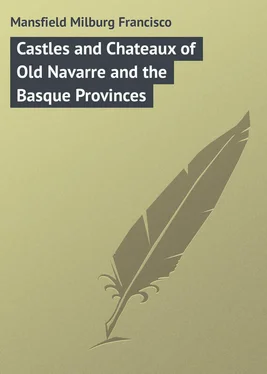Milburg Mansfield - Castles and Chateaux of Old Navarre and the Basque Provinces
Здесь есть возможность читать онлайн «Milburg Mansfield - Castles and Chateaux of Old Navarre and the Basque Provinces» — ознакомительный отрывок электронной книги совершенно бесплатно, а после прочтения отрывка купить полную версию. В некоторых случаях можно слушать аудио, скачать через торрент в формате fb2 и присутствует краткое содержание. ISBN: , Жанр: foreign_prose, на английском языке. Описание произведения, (предисловие) а так же отзывы посетителей доступны на портале библиотеки ЛибКат.
- Название:Castles and Chateaux of Old Navarre and the Basque Provinces
- Автор:
- Жанр:
- Год:неизвестен
- ISBN:http://www.gutenberg.org/ebooks/43609
- Рейтинг книги:4 / 5. Голосов: 1
-
Избранное:Добавить в избранное
- Отзывы:
-
Ваша оценка:
- 80
- 1
- 2
- 3
- 4
- 5
Castles and Chateaux of Old Navarre and the Basque Provinces: краткое содержание, описание и аннотация
Предлагаем к чтению аннотацию, описание, краткое содержание или предисловие (зависит от того, что написал сам автор книги «Castles and Chateaux of Old Navarre and the Basque Provinces»). Если вы не нашли необходимую информацию о книге — напишите в комментариях, мы постараемся отыскать её.
Castles and Chateaux of Old Navarre and the Basque Provinces — читать онлайн ознакомительный отрывок
Ниже представлен текст книги, разбитый по страницам. Система сохранения места последней прочитанной страницы, позволяет с удобством читать онлайн бесплатно книгу «Castles and Chateaux of Old Navarre and the Basque Provinces», без необходимости каждый раз заново искать на чём Вы остановились. Поставьте закладку, и сможете в любой момент перейти на страницу, на которой закончили чтение.
Интервал:
Закладка:
One finds a bit of superstitious ignorance once and again, even in enlightened France of to-day. It was not far from here, on the road to the Col de Banyuls, that we were asked by a peasant from what country we came. He was told by way of a joke that we were Chinese. “ Est-ce loin? ” he asked. “ Deux cents lieues! ” “ Diable! c’est une bonne distance! ” One suspects that he knew more than he was given credit for, and perhaps it was he that was doing the joking, for he said by way of parting: “ Ma foi, c’est bien triste d’être si loin de votre mère. ”
What a little land of contrasts the region of the Pyrenees is! It is all things to all men. From the low-lying valleys and sea-coast plains, as one ascends into the upper regions, it is as if one went at once into another country. Certainly no greater contrast is marked in all France than that between the Hautes-Pyrénées and the Landes for instance.
The Hautes-Pyrénées of to-day was formerly made up of Bigorre, Armagnac and the extreme southerly portion of Gascogne. Cæsar called the people Tarbelli, Bigerriones and Flussates, and Visigoths, Franks and Gascons prevailed over their destinies in turn.
In the early feudal epoch Bigorre, “the country of the four valleys,” had its own counts, but was united with Béarn in 1252, becoming a part of the patrimony which Henri Quatre brought ultimately to the crown of France.
Antiquities before the middle ages are rare in these parts, in spite of the memories remaining from Roman times. Perhaps the greatest of these are the baths and springs at Cauterets, one of them being known as the Bains des Espagnoles and the other as the Bains de Cesar. These unquestionably were developed in Roman times.
The chief architectural glory of the region is the ancient city of St. Bertrand, the capital of Comminges, the ancient Lugdunum Convenarum of Strabon and Pliny. Its fortifications and its remarkable cathedral place it in the ranks with Carcassonne, Aigues-Mortes and Béziers.
The manners and customs of the Bigordans of the towns (not to be confounded with the Bigoudens of Brittany) have succumbed somewhat to the importation of outside ideas by the masses who throng their baths and springs, but nevertheless their main characteristics stand out plainly.
Quite different from the Béarnais are the Bigordans, and, somewhat uncharitably, the latter have a proverb which given in their own tongue is as follows: – “ Béarnès faus et courtès. ” Neighbourly jealousy accounts for this. The Béarnais are morose, steady and commercial, the Bigordans lively, bright and active, and their sociability is famed afar.
In the open country throughout the Pyrenees, there are three classes of inhabitants, those of the mountains and high valleys, those of the slopes, and those of the plains. The first are hard-working and active, but often ignorant and superstitious; the second are more gay, less frugal and better livers than the mountaineers; and those of the plains are often downright lazy and indolent. The mendicant race, of which old writers told, has apparently disappeared. There are practically no beggars in France except gypsies, and there is no mistaking a gypsy for any other species.
In general one can say that the inhabitants of the high Pyrenees are a simple, good and generous people, and far less given to excess than many others of the heterogeneous mass which make up the population of modern France.
Simple and commodious and made of the wool of the country are the general characteristics of the costumes of these parts, as indeed they are of most mountain regions. But the distinctive feature, with the men as with the women, is the topknot coiffure. In the plains, the men wear the pancake-like béret , and in the high valleys a sort of a woollen bonnet – something like a Phrygian cap. With the women it is a sort of a hood of red woollen stuff, black-bordered and exceedingly picturesque. “ C’est un joli cadre pour le visage d’une jolie femme ,” said a fat commercial traveller, with an eye for pretty women, whom the writer met at a Tarbes table d’hôte.
A writer of another century, presumably untravelled, in describing the folk of the Pyrenees remarked: “The Highlanders of the Pyrenees put one in mind of Scotland; they have round, flat caps and loose breeches.” Never mind the breeches, but the béret of the Basque is no more like the tam-o’-shanter of the Scot than is an anchovy like a herring.
An English traveller once remarked on the peculiar manner of transport in these parts in emphatic fashion. “With more sense than John Bull, the Pyrenean carter knows how to build and load his wagon to the best advantage,” he said. He referred to the great carts for transporting wine casks and barrels, built with the hind wheels much higher than the front ones. It’s a simple mechanical exposition of the principle that a wagon so built goes up-hill much easier.
Here in the Hautes-Pyrénées they speak the speech of Languedoc, with variations, idioms and bizarre interpolations, which may be Spanish, but sound like Arabic. At any rate it’s a beautiful, lisping patois , not at all like the speech of Paris, “twanged through the nose,” as the men of the Midi said of it when they went up to the capital in Revolutionary times “to help capture the king’s castle.”
The great literary light of the region was Despourrins, a poet of the eighteenth century, whose verses have found a permanent place in French literature, and whose rhymes were chanted as were those of the troubadours of centuries before.
To just how great an extent the patois differs from the French tongue the following verse of Despourrins will show: —
“Aci, debat aqueste peyre,
Repaüse lou plus gran de touts lou médecis,
Qui de poü d’està chens besis,
En a remplit lou cimetyre.
“Ici, sous cette pierre,
Repose le plus grand de tous les médicins,
Qui de peur d’être sans voisins
En a rempli le cimetière.”
A humourist also was this great poet!
Throughout the Pyrenean provinces, and along the shores of the Mediterranean, from Catalonia to the Bouches-du-Rhône are found the Gitanos, or the French Gypsies, who do not differ greatly from others of their tribe wherever found. This perhaps is accounted for by the fact that the shrines of their patron saint – Sara, the servant of the “Three Maries” exiled from Judea, and who settled at Les Saintes Maries-de-la-Mer – was located near the mouth of the Rhône. This same shrine is a place of pilgrimage for the gypsies of all the world, and on the twenty-fourth of May one may see sights here such as can be equalled nowhere else. Not many travellers’ itineraries have ever included a visit to this humble and lonesome little fishing village of the Bouches-du-Rhône, judging from the infrequency with which one meets written accounts.
Gypsy bands are numerous all through the Départements of the south of France, especially in Hérault and the Pyrénées-Orientales. Like most of their kind they are usually horse-traders, and perhaps horse-stealers, for their ideas of honesty and probity are not those of other men. They sometimes practise as sort of quack horse-doctors and horse and dog clippers, etc., and the women either make baskets, or, more frequently, simply beg, or “ tire les cartes ” and tell fortunes. They sing and dance and do many other things honest and dishonest to make a livelihood. Their world’s belongings are few and their wants are not great. For the most part their possessions consist only of their personal belongings, a horse, a donkey or a mule, their caravan, or roulotte , and a gold or silver chain or two, ear-rings in their ears, and a knife – of course a knife, for the vagabond gypsy doesn’t fight with fire-arms.
Читать дальшеИнтервал:
Закладка:
Похожие книги на «Castles and Chateaux of Old Navarre and the Basque Provinces»
Представляем Вашему вниманию похожие книги на «Castles and Chateaux of Old Navarre and the Basque Provinces» списком для выбора. Мы отобрали схожую по названию и смыслу литературу в надежде предоставить читателям больше вариантов отыскать новые, интересные, ещё непрочитанные произведения.
Обсуждение, отзывы о книге «Castles and Chateaux of Old Navarre and the Basque Provinces» и просто собственные мнения читателей. Оставьте ваши комментарии, напишите, что Вы думаете о произведении, его смысле или главных героях. Укажите что конкретно понравилось, а что нет, и почему Вы так считаете.












